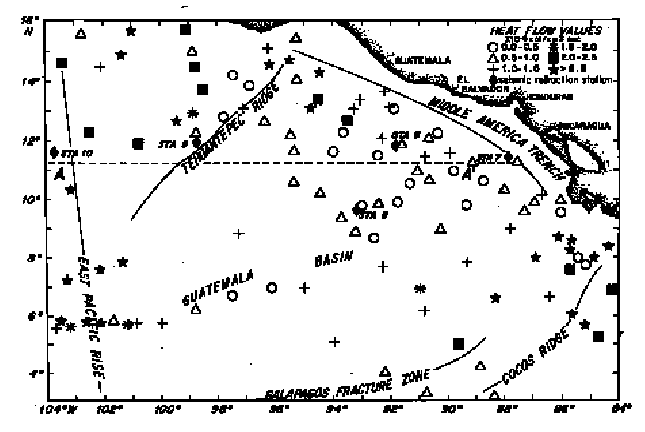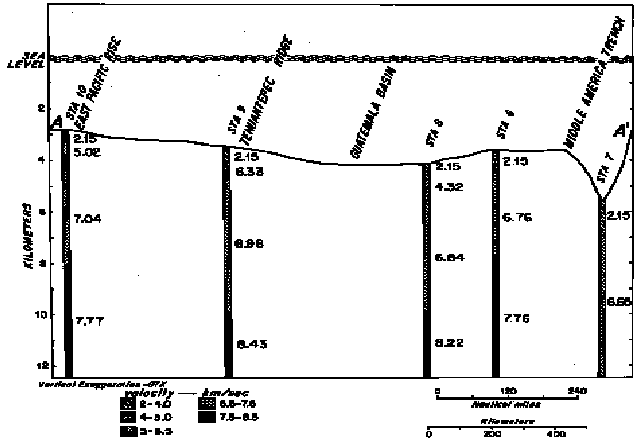Description
Age of the Guatemala Basin
Top
Assuming a sea-floor spreading rate of 4 cm/yr from the crest of the East Pacific Rise yields a maximum possible age for a crater of 6 m.y.
Isostatic rebound
Top
That the topographic contrast of the basin is not greater at present we attribute to the rapid rate, <10
5
years, at which such a large diameter area returns to isostatic equilibrium (Haskell, 1937).
Cratering rates
Top
From the work done by Urey (1957) on the frequency of cometary impacts, and Brown (1960) and Baldwin (1963) on the frequency of meteorite impacts, it appears reasonable that within the age of the ocean basins, 10
8
years, that at least one to three extraterrestrial bodies with sufficient energy to cause such a crater have collided with the earth.
These statistics would make it improbable that such an impact has occurred with the past few m.y. However, from the age range of known tektites, and assuming that tektites are splash from large energy meteorite impacts (Urey, 1957, Lin, 1966, and now generally accepted), whether of terrestrial or moon origin, we should like to argue that the frequency of large energy impacts may be much greater that previously supposed (Nininger,1963, and now well established).
If tektites do originate on the moon then for every impact on the moon capable of ejecting tektite material there must be, on average, at least 13.6 impacts on the earth based on relative cross-sections. Brown (1960) adds ~30% more terrestrial impacts to the above cross section figures to account for the larger gravity effects of the earth. Glass (1967) and Glass and Heezen (1967) have shown a possible relationship between tektites and geomagnetic reversals. If this relationship were valid throughout the age of the ocean basins, then ~200 impacts (Heirtzler and others, 1968) of energies
≥
10
30
ergs (Lin, 1966) have occurred in the last 10
8
years.
Cratering and ocean basin formation
Top
(I would not want to defend this section today, but it is left in to illustrate the state of knowledge about the ocean basins at the time of writing.)
Due to the tsunami effects of shock radiating through the crust and mantle, a crater the size of the Guatemala Basin would completely alter an area at least twice its diameter, or ~3x10
6
km
2
. Two hundred such events in 10
8
years are then more than adequate to have created the ocean basins on the basis of area cratered and altered by cratering. This impact frequency is also in approximate agreement with that calculated by Cohenour and Sharp (1968). The time-frequency boundaries above are not necessarily limiting for a hypothesis of formation of the ocean basins by impact, as second order effects may well serve to give ocean basins an appearance of youth with a greatly reduced frequency of impacts, as has been postulated by Harrison (1960).
Crater dimensions
Top
Some relevant statistics on our proposed crater: mean diameter ~1,100 km; energy required ~10
35
ergs (Chapman and Gault, 1967). Assuming an impact velocity of 42 km/sec (Urey, 1957) the diameters of bodies required to produce this amount of energy are: (1) stony meteorite with density of 3.5 gm/cm
3
, 85 km; (2) iron meteorite with a density of 8 gm/cm
3
, 65 km; and for a comet with a mean density of 0.01 gm/cm
3
, 600 km. The original crater depth would be on the order of 150 km (Chabai, 1965) with a residual depth of roughly 25 km. The time for such a crater to reach isostatic equilibrium would be ~40,000 years (Haskell, 1937). A crater ~1,000 km in diameter and ~150 km deep would lower sea level ~320 m. At the residual crater depth of ~25 km, sea level would still be lowered ~55 m. It should be noted that large uncertainties exist in the above figures and the approximations are probably not better than ±25%.
Conclusions
Top
The earth must be as frequently cratered per unit area as the moon. By a relative cross section argument, more than 13 times the number of craters the size of the maria on the moon exist, or existed, on the earth. Whether such events occur with sufficient frequency in recent geologic time to provide tangible evidence today of such cratering is uncertain. From the arguments set forth, and the continuing discovery of meteorite craters on the continents (Short, 1966, Baldwin, 1963, Dietz, 1961, and Prouty, 1952) it seems likely that the importance of the effect of extraterrestrial bodies impacting the earth has been, at least, underestimated (the Alverez's hypothesis concerning the end of the dinosaurs by such a mechanism was more than a decade in the future). Certainly there is as much evidence at present to support our hypothesis for the formation of the Guatemala Basin as other hypotheses advanced to explain the low heat flow found in this basin.
With the tests for shock processes advanced by Short (1966), our hypothesis should be capable of field verification or rejection.
Acknowledgement
Top
We should like to thank Dr. Russell Raitt for allowing us to use previously unpublished data. The work was partially supported by NSF grants GM-7 and GP-3791 at Scripps Institution of Oceanography, and NSF grant GA-1448 at the Woods Hole Oceanographic Institution.
References
Top
Baldwin, R. B., The measure of the moon, Univ. of Chicago Press (1963).
Brown, H.,
J. Geophys. Res.,
65,
1679-1683 (1960).
Bullard, E. C., Maxwell, A. E., and Revelle, R.,
Advan. Geophys.,
3
, 153-181 (1956).
Chabai, A. J.,
J. Geophys. Res.,
70
(20), 5075-5097 (1965).
Chapman, D. R. and Gault, D. E.,
J. Geophys. Res.,
72
(10), 2695-2699 (1967).
Cohenour, R. E. and Sharp, B. J.,
Geoscience News,
1,
3, 9-11; 32-34 (1968).
Dietz, R. S.,
Sci. Am.,
205,
2, 50-58 (1961).
Dietz, R. S.,
Am. J. Sci.,
261,
650-664 (1963).
Harrison, E. R.,
Nature,
188,
1064-1067 (1960).
Haskell, N. A.,
Am. J. Sci.,
33,
22 (1937).
Heirtzler, J. R., Dickson, G. O., Herron, E. M., Pitman, W. C., III, and LePichon, X.,
J. Geophys. Res.,
73,
6, 2119-2135 (1968).
Glass, B.,
Nature,
214,
5086, 372-374 (1967).
Glass, B. and Heezen, B. C.,
Scien. Am.,
217,
1, 32-38 (1967).
Lin, S. C. J.,
J. Geophys. Res.,
71
(10), 2427-2437 (1966).
Nininger, H. H., The Solar System,
4,
Chap. 6, 162-182, Univ. of Chicago Press (1963).
Prouty, W. F.,
Bull. Geol. Soc. Am.,
63
, 167-224 (1952).
Raitt, R., Seismic refraction studies on Chubasco expedition, unpublished (at the time).
Shor, G. G. Jr. and Fisher, R. L.,
Bull. Geol. Soc. Am.,
72,
721-730 (1961).
Short, N. N.,
J. Geol. Education,
XIV, 4, 149-166 (1966).
Urey, H. C.,
Nature,
179,
556-557 (1957).
Vacquier, V., Sclater, J. G., and Corry, C. E.,
Bull. Earthquake Res. Inst.,
45,
375-393, Tokyo (1967).
Von Herzen, R. P.,
Nature,
183,
882-883 (1959).
Von Herzen, R. P. and Uyeda, S.,
J. Geophys. Res.,
68
(14), 4219-4250 (1963).
Top
|
Home Page
|
Contents
|
Index
|
Comments?
|
|
Chapter — Geophysics
|
|
Next - Leakage from underground storage tanks
|
|
Back - Ferroelectricity
|
Last modified 4/29/19

